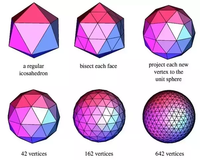You are using an out of date browser. It may not display this or other websites correctly.
You should upgrade or use an alternative browser.
You should upgrade or use an alternative browser.
Icosahedron Issue
- Thread starter akwardcy
- Start date
Dr.Peterson
Elite Member
- Joined
- Nov 12, 2017
- Messages
- 16,106
Clearly these are not regular, since there are only five as you say.
What is the definition of "regular"? What part do you think might not be satisfied?
What is the definition of "regular"? What part do you think might not be satisfied?
Dr.Peterson
Elite Member
- Joined
- Nov 12, 2017
- Messages
- 16,106
Please state the definition of "regular", and apply it to, say, the last image in the first row. (If that isn't regular, then you can't expect the rest to be.)
These figures are all convex; that is not the issue.
These figures are all convex; that is not the issue.
D
Deleted member 4993
Guest
Have read the following article:The issue is to project radially from center on a sphere points bisected on icosahedron but i still cannot understand what is that solid which has eg 642 vertices and is it a regular solid? because plato said there is only 5 of them idk HELP
https://en.wikipedia.org/wiki/Archimedean_solid
Dr.Peterson
Elite Member
- Joined
- Nov 12, 2017
- Messages
- 16,106
Because it is not convex I think but in limit converging to infinity it might be anyway thanks you
You seem to have leaped from "might be" to "would be", with no reason given.I've tried to explain that in limit we can find perfect tesselation where all the faces on sphere would be exact the same but im first year student and meybe missed something
WHY do you believe that all the faces, even if not congruent in finite cases, would approach congruence in the limit? Mathematics is not about feelings, but about proof. You show no evidence of doing anything like a proof. You claim to have "explained", but I don't even see any explanation.
Of course, your initial question was not about the limiting case at all. Have you accepted the answer to that yet? Have you thought about what I said?
It's because I persistently tried to find any aproxymation of sphere in any possible limit, like we can do this for circle with regular polygon when we increase number of sides. And that was my primary thought because I felt like there must by any kind of polyhedron class wich increasing number of faces to infinity in limit give us sphere and then I also think that is a rule that for n-th number of faces formula for volume is given. And I really want to find out one. That's all.
Dr.Peterson
Elite Member
- Joined
- Nov 12, 2017
- Messages
- 16,106
I'm not at all sure what your real goal is. You asked about "regular solids"; then you mentioned "perfect tesselation where all the faces on sphere would be exact the same", which I suppose is meant to mean the same thing.
But none of that is necessary if your goal is just to approximate the sphere with a polyhedron. That's easy enough.
On the other hand, if you want to find the area or volume of the sphere by your sequence of polyhedra, you need to be able to find the volume or area of the polyhedra, and that is probably difficult with those you are asking about, because they are not as regular as you were hoping.
Try a different kind of polyhedron instead. If I were trying to find the volume (and didn't know what I already know), I might try using latitude and longitude lines to divide up the sphere, and turn that into an approximating polyhedron.
The method used by Archimedes and others to find the volume and area of a sphere was somewhat like this, but a little different. They did not try anything like regular polyhedra because they knew, as you do, that they are very rare, and can't have n>20.
But none of that is necessary if your goal is just to approximate the sphere with a polyhedron. That's easy enough.
On the other hand, if you want to find the area or volume of the sphere by your sequence of polyhedra, you need to be able to find the volume or area of the polyhedra, and that is probably difficult with those you are asking about, because they are not as regular as you were hoping.
Try a different kind of polyhedron instead. If I were trying to find the volume (and didn't know what I already know), I might try using latitude and longitude lines to divide up the sphere, and turn that into an approximating polyhedron.
The method used by Archimedes and others to find the volume and area of a sphere was somewhat like this, but a little different. They did not try anything like regular polyhedra because they knew, as you do, that they are very rare, and can't have n>20.

